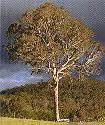Centre for Plant Biodiversity Research
M.I.H. Brooker, J.R. Connors and A.V. Slee   
It has been produced by the Centre for Plant Biodiversity Research from the Australian National Herbarium database of over 60 000 eucalypt specimens as well as information derived from glasshouse studies for details of comparative juvenile morphology, and from widespread field observations. It was first published in 1997 and has now been revised to include all the species of Angophora. Eucalypts have been difficult to identify in the past but now with EUCLID and a minimum of plant material and/or instructive illustrations, the task has been made simple. EUCLID (EUCaLyptus IDentification) allows the user to quickly and easily identify any of the 324 species and subspecies of Eucalyptus and Angophora native to south-eastern Australia, i.e. New South Wales, Australian Capital Territory, Victoria, Tasmania and part of South Australia.

Identifications are achieved by matching features of the specimen with features from any of the 120 different characters available in the key. The characters are arranged into sets and these sets contain information about the natural distribution, habit, bark, flower buds, fruits, seeds, juvenile leaves, and habitat. Characters can be selected in any order. The great advantage over traditional identification keys is that EUCLID gives the freedom to avoid characters that are unavailable or difficult to assess. To enhance the word descriptions, each character is illustrated by line drawings, colour pictures or scanning electron micrographs. Most species are also illustrated by a range of colour photos of the habit, bark, leaf venation, buds, flowers, fruits and a map of the natural geographic distribution.
   
The database includes extra information on nomenclature and synonymies, a description of each species, notes on related or similar species and how they may be distinguished. Uses for the species such as timber, fibre, honey production, shelter and ornamentation are also included. The next phase of this project, Euclid II - Eucalypts of south-western
Australia, is well under way and is due for completion in the year
2001. When finished, it will include all the species and subspecies (c.
420 taxa) that are native to South Australia and the area of Western Australia
south of the 26 th line of latitude.

Audience
Features
EUCLID (revised edition) Order Form  
Updated Monday, 20/12/1999 09:53:18 EST by John Connors |